The following report was commissioned by Urbit, a member of Messari Hub. For additional information, please see the disclaimers following the article.
Key Takeaways:
- Urbit is a private, digital homestead for all-around Web3 usage; its peer-to-peer OS offers cloud and community-based services.
- It’s built from the ground up and runs on almost any phone, tablet, laptop—or anything with Unix and an internet connection.
- The real test for Urbit is building a sustainable user community and leveraging infrastructure as a business model.
Internet users often rely on third-party services to stream, store, or create content. Be it Netflix, Spotify, Youtube, or Notion, these third-party services often monetize user time or data. So why do most users continue to over-rely on third-party services? According to the founder of Signal messaging app, a potential explanation is that users ‘do not want to run their own servers’ because it’s technically complicated. So most users end up using what their peers also use. But there are viable solutions to this problem: Urbit is a prominent example of a protocol that allows anyone to run their own private server and interact with peers. Add to this a suite of cloud services and seamless usage without ads, tracking, or any data capture.
What Is Urbit? Digital Homestead
Imagine an extensible, open source version of WeChat: Urbit is a one-stop-shop suite of cloud and community-based services. It offers user-focused functionalities for collaboration, communication, and commerce. Urbit is designed to give users digital autonomy. It’s like decorating a digital homestead from scratch with built-in privacy: Urbit allows users to privately store their own data, digital assets, and directly communicate with peers without any third-party interference. Urbit can run on almost any phone, tablet, laptop, server—or anything with Unix and an internet connection. Urbit aims to be more personal, customizable, and durable than other existing computing platforms.

Source: urbit.org
Customization is King
Each Urbit service can be tailored to individual user needs; this is in contrast to the walled-garden experience of many Web2 apps: often easy to use, but less often customized to individual needs. Anyone may create tailored Urbit services based on their own vision of how Urbit should be developed. To enable custom communication and collaboration, one of the main Urbit GitHub contributors – Tlon – has created the Landscape interface, which serves as a robust toolkit for allround Web3 use. To interact with other users, Landscape enables direct chats, posting notebook entries, sharing links in reddit-style, and forming sub-communities. Project Uqbar has recently forked Landscape, offering a simple way to organize groups and an updated user interface. Other notable contributors to Urbit’s kernel include: the Tirrel Corporation, an Urbit-focused payments processor; urbit.live, a marketplace for Urbit IDs; urbithost, a server hosting provider; and dcSpark, a product-focused startup building on Urbit.
Technology in a Nutshell
At its core, Urbit is a peer-to-peer computer network that runs an operating system (OS). In a nutshell, Urbit comprises two pieces of technology:
Peer-to-Peer Computer Network (Urbit ID): is a distributed identity and public key infrastructure (PKI) for general-purpose authentication. An Urbit ID is like a login, network address, and Web3 wallet all in one. While Urbit IDs are instantiated as ERC-721 non-fungible tokens on the Ethereum smart contract platform, they could be secured by any other smart contract platform or even by a future Urbit Layer 1. Urbit IDs can be cryptographically owned and used as login to the Urbit network, in a similar way Blockscan and Kepler leverage ‘Log-in With Ethereum‘. This removes the need for login data to be provisioned by a third-party.
Urbit ID enables distributed ownership of the network by its users. It’s somewhat like owning a piece of a Web3 version of TCP/IP, except that Urbit ID gives users control over their data and privacy. Based on their roles on the network, Urbit IDs are organized through a hierarchy: at the top are governance nodes (called galaxies); below galaxies are infrastructure nodes (called stars), responsible for packet routing and peer discovery. Below stars are individual nodes (called planets), that enable network access for everyday use. Any Urbit node is given full flexibility to run any version of Urbit software they choose to.
Operating System (Urbit OS): is a virtual computing platform built from the ground up. It is completely sealed from the system it runs on, somewhat like Web Assembly (WASM) or the Java Virtual Machine (JVM). The Urbit OS is best described as an ‘overlay OS,’ in that it runs on top of other environments. Landscape offers a simple interface and community-based services that enable direct, encrypted communication between authenticated users. Every message from a source Urbit ID is encrypted and sent directly to the destination Urbit ID without any interference. Urbit allows users to flexibly deploy any version of the Urbit software to a server of choice. For users who value being in full control, Urbit can be hosted on a local machine. For users who value convenience, Urbit can be hosted via a cloud provider of choice.
The peer-to-peer network, identity system, and the virtual computing stack can be further explored here.
Research and Development Journey
A niche research project aimed to re-engineer computing from first principles almost two decades ago. This research was the origin of the development of the Urbit network, which has been operational since 2013. Urbit software releases are inherently decentralized: they are determined by consensus of the core developers, primarily through planning, proposals, and discussions on the Urbit GitHub repository. The Galactic Senate, composed of Urbit’s governance nodes (galaxies), may vote on any change proposal. Forks incentivize governance and infrastructure nodes to be reliable service providers for individual nodes.
The chart below indicates the most notable GitHub software releases. The pace of Urbit development has been intensifying as Urbit ID went live on Ethereum in 2019 and released the first version of Urbit OS in 2020. Urbit subsequently underwent an independent security audit and released a Bitcoin wallet in 2021. Today, Urbit is a mature system that offers stable infrastructure. Urbit engineered and recently released a Layer 2 rollup, making everyday use more affordable for anyone. Transactions are performed on Urbit, submitted to a roller, which then get processed on-chain in batches. An overview of the main software releases from Urbit inception is available here.
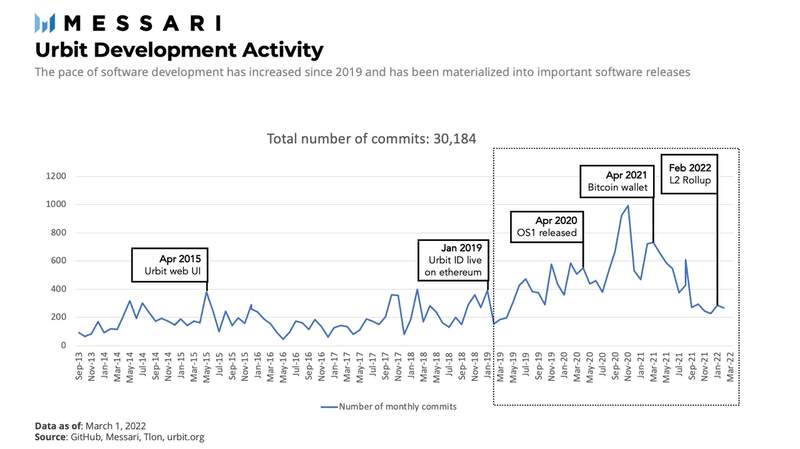
Deeper Dive: Distributed Identity
The immediate use case for Urbit ID is authentication into Urbit OS: the Urbit identity protocol is used to uniquely differentiate between Urbit OS users. Put simply, it determines that the person who is talking to you is who they say they are: by signing their messages cryptographically, users are attesting their identity. But there’s more than that: the Urbit ID system provides a set of identities as cryptographic assets.
Cryptographic Asset
An Urbit ID is an ERC-721 non-fungible token—a single 32-bit number—translated into a pronounceable, unique name and a visual icon (referred to as a sigil). For instance, the Urbit ID ~tinbel-picpel and the sigil below have been uniquely mapped to the number 3,500,433,403.
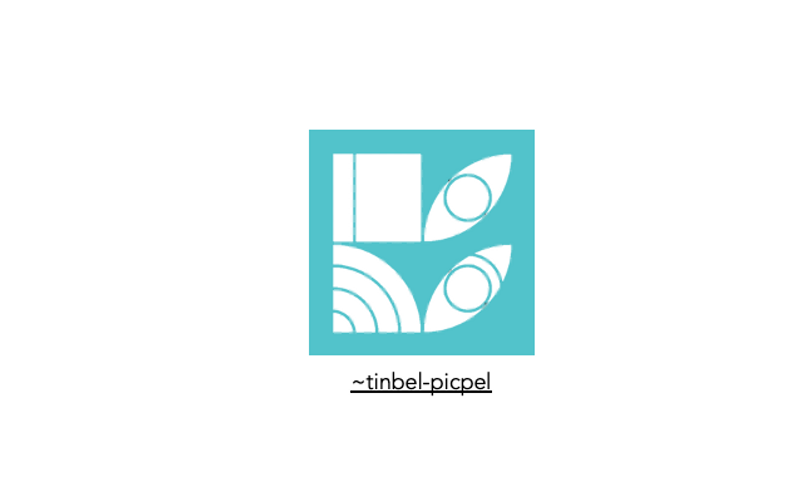
Source: https://urbit.live/~tinbel-picpel
The combination of ~tinbel-picpel (public key) and ~winter-paches-palfun-foslup (private key) allows a user to log into Urbit OS. The ownership registry that stores the mappings between public keys and their corresponding private keys has been live on the Ethereum blockchain since 2019.
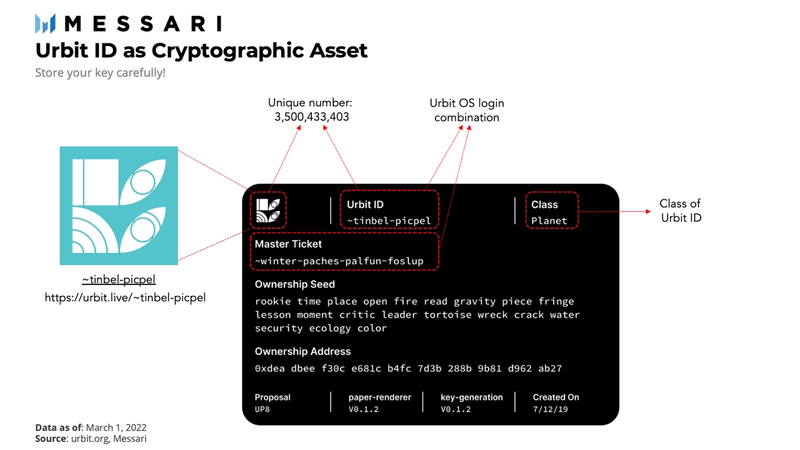
From Urbit IDs to Network Nodes
Besides being NFTs, Urbit IDs correspond to nodes on the Urbit network. One can distinguish three classes of Urbit nodes based on their role: governance nodes (galaxies), infrastructure nodes (called stars), and personal nodes (planets). In practice, personal nodes (planets) use services provided by infrastructure nodes (stars). In simplified terms, stars can be regarded as Internet Service Providers (ISPs) for planets. For example, a star might offer hosting, while another might offer add-on services like content delivery network (CDN) or Bitcoin-related nodal services. Other services include: software updates, data packet routing, and peer discovery. Conversely, governance nodes (galaxies) can be regarded as DNS root nodes that provide services to infrastructure nodes (stars).
Galaxies provide services to stars, while stars provide services to planets. Additionally, galaxies form the Galactic Senate that governs the suite of smart contracts on Ethereum that secure the Urbit ID system. When it comes to software updates and releases, any galaxy can propose any vote at any time and choose to run any version of Urbit software. While there is no requirement to adhere to a particular version, simply choosing to run the latest version makes it easier for everyday usage.
Urbit Tree Doesn’t Grow to the Sky
Given this hierarchical division of roles on the Urbit network, the natural way to visualize galaxies, stars, and planets is using a hierarchical tree. That is, three layers stacked on top of each other: at the top layer are the governance nodes (galaxies); at the middle layer are the infrastructure nodes (stars); whereas at the bottom layer are the personal nodes (planets).
The number of Urbit IDs is bound by design: there will only ever be 2^8 galaxies. Each galaxy can distribute 2^8-1 = 255 stars. There will only ever be a maximum 2^16 stars. Each star can distribute 2^16-1 = 65,535 planets. There will only ever be a maximum 2^32 planets. Summing up, this makes a total of less than 4.3 billion galaxies, stars, and planets combined. Below is a snapshot of the hierarchical tree of Urbit nodes.
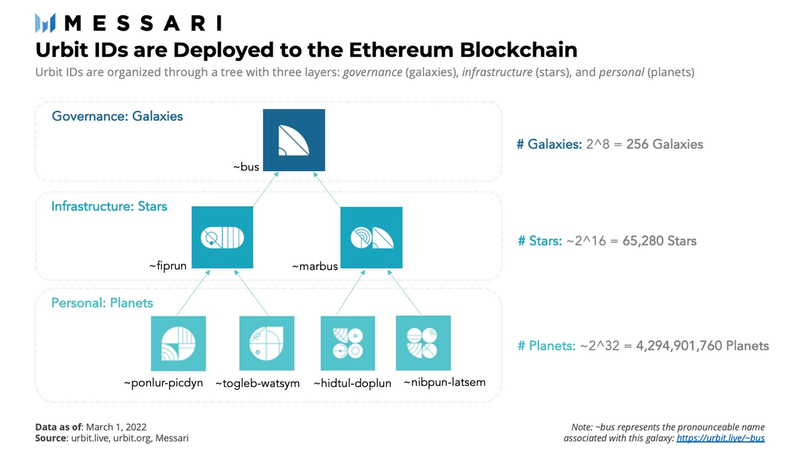
Token Economics
All Urbit IDs were created simultaneously upon the initiation of the Urbit network. Some of the Urbit addresses remain locked in smart contracts that prevent any transferring of the IDs. These Urbit IDs are scheduled to unlock linearly until 2025: urbit.org and early prize awardees unlock linearly from 2019 until 2021; early contributors, code developers, and employees unlock linearly from 2020 until 2023; private buyers unlock over one or three years based on terms of their respective contracts. Live Urbit network activity can be explored here.
By January 2024, all stars will be unlocked and available for trading. Unlocked stars are subject to spawning limits, meaning there are limits to how many planets a star can generate, which prolongs the lockup period for planets until the following year. Thus, planets will finish unlocking by January 2025.

As the scarcest of Urbit network nodes, galaxies are primarily available on over-the-counter (OTC) desks, and rarely appear for sale on open markets. Stars and planets trade regularly on various platforms such as: urbit.live, OpenSea, planet.market, urbit.me, urth systems, urbithost, urbitex.io, or Urbit Marketplace.
On one hand, planet sales transactions have been relatively steady over time: 5,255 transactions with an average price: $50 USD and one notable exception – planet ~fasmut-worner has been sold on 11/25/2021 for close to $16,000 USD. As each Urbit ID is unique, they tend to be purchased by users for their specific characteristics: names that rhyme or resemble English words are particularly appealing. Planets whose icons have circular sigils often sell for significantly more than the average price. As an example, planet ~parret-barret sold for about $1,000 USD at a time when most planets were selling for $10-20.
On the other hand, star sales have been gaining in transaction value recently – the most expensive star ~samfeb has been sold on 9/4/2021 for more than $31,000 USD. In total, there have been 1,067 transactions involving stars on urbit.live with an average price of approx. $7,300 USD per star. Wrapped stars (WSTR) trade against ETH on Uniswap as of November 2021.
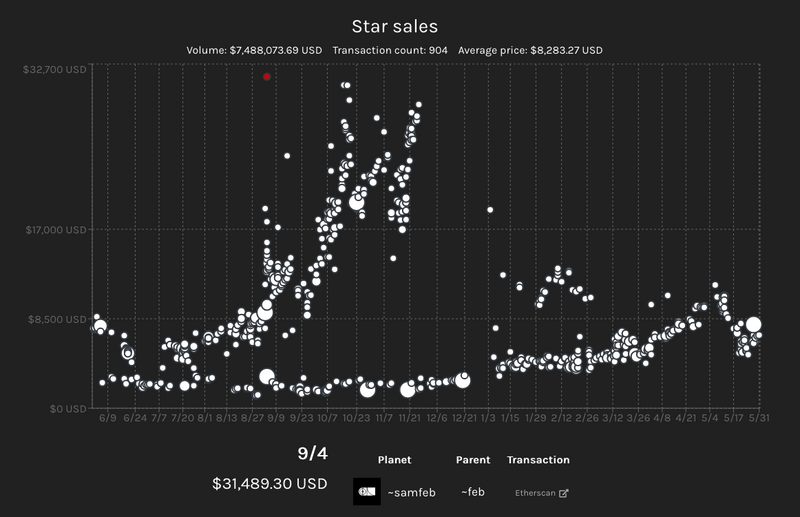
Source: https://urbit.live/stats
A portion of Urbit IDs (15,935 items) are currently being listed on OpenSea:

Is Urbit Spam-Proof?
Urbit ID’s scarcity, persistent reputation and flexible design may have second-order effects in terms of incentivizing good behavior on the Urbit network.
Identity scarcity: The number of Urbit IDs is finite which engenders a natural scarcity – there will ever be just less than 4.3 billion unique Urbit IDs and each has a price tag. This means that when a user interacts with a stranger on the Urbit network, they both have skin in the game. Because Urbit IDs are scarce, the more actively used the Urbit system is, the more valuable Urbit IDs are likely to become. This may further discourage “risk-free” exploits of Urbit IDs.
Persistent reputation: As a public key infrastructure (PKI), Urbit ID has been designed to promote Urbit’s values: an identity needs to be persistent, self-sovereign, and globally consistent (uniquely identifiable). The value of permanent identity translates into accruing a persistent reputation based on the activity of each Urbit ID. Any potential adversarial behavior on the network is added to the persistent reputation. Because reputation follows each individual Urbit ID, good network behavior is inherently incentivized.
Flexible design: The Urbit system is designed to account for flexibility: any galaxy, star, or planet can run any version of Urbit software they choose to. Another example is: planets can choose their stars and galaxies based on software functionalities, user communities, or any criteria that suit their needs. Planets can easily move around the Urbit network to find a new sponsor star in the Urbit tree. This design choice incentivizes galaxies and planets to be reliable service providers for planets. Conversely, stars and galaxies can essentially block planets from spamming the network or from exercising any bad behavior.
Thus, an important second-order implication of identity scarcity, permanent reputation, and modular design is that the Urbit system may become spam-proof: if an Urbit ID behaves as a bad actor, it damages their persistent reputation on the network. Higher value of Urbit IDs may discourage spam, bots, scams, or spreading malware: if Urbit ID NFTs become valuable enough, it would be too expensive for users trying to spam the Urbit network by creating multiple addresses or by essentially compromising the persistent reputation of individual Urbit IDs. This is in contrast to being able to cheaply create email addresses used for spamming.
Opportunities: The Sky’s the Limit
Today, the Urbit network is a stable, secure software that runs on most cloud servers, laptops, and mobile phones as an ‘overlay OS’. Through interface implementations such as Landscape, Urbit strives to become more personal, private, and durable than any existing computing platform.
Urbit Usage
Urbit is a space meant for communities of users who may want to creatively customize and have control over their digital environment. Today, Urbit is primarily used by developers, and by communities of privacy enthusiasts, tinkerers, and hobbyists. But for Urbit to get a chance of living up to its aspirations, it needs to expand its user base beyond communities of tech-savvy explorers. As the Urbit network transitions from a community of early adopters to digital communities, the increasing market value of Urbit IDs may provide more resources for developers to advance code development. This, in turn, may lead to increased network utility for everyday use and may further stimulate Urbit’s expansion.
So how can Urbit increase its user adoption? According to the technology acceptance model (TAM), the two most important factors contributing to increased user adoption are: ease of use and usefulness. Let’s explore how this translates to Urbit.
In terms of ease of use, Urbit aims to lower the entry barriers for regular, non-technical users: Urbit OS can be used conveniently via a hosting service. In this sense, some stars act as hosting service providers for users who want to run their planet in the cloud, as opposed to running it locally. To ease up user life, some stars offer service bundles consisting of planet acquisition, set-up, hosting, alongside packet routing and peer discovery. Add to that a simple and intuitive user interface.
In terms of usefulness, Urbit aims to tailor its services to the needs of user communities. Urbit aims to continue iterating on the infrastructure, while, at the same time, allowing communities themselves to identify, create, and expand on useful features based on their needs.

Source: urbit.org
Community of Communities: Look to the Stars
Be it posting blog entries or sharing links in reddit-style: Urbit is designed for communities to interact with each other. Planets have full flexibility over how they choose to connect with other planets. Each planet can decide how much personal information to share with whom.
Stars act as Schelling points for their planets, being the natural point of spanning sub-communities of planets. Stars enable individual communities to customize their experiences, design their own software for their own usage, while being privacy-protected from the outside world. To date, 7,802 stars have been activated on the Urbit network and this number is expected to grow as communities are getting onboarded into Urbit.
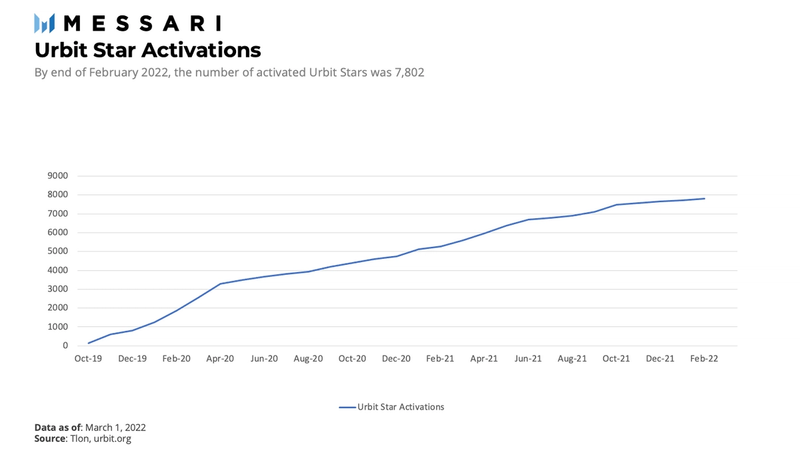
In this sense, stars may represent the starting point of forming durable ties in a flourishing ecosystem: a community of communities. Within the Urbit target are communities of communities, such as Dalten Collective, point DAO, OtherLife, dcSpark, or dOrg, in need of flexible collaboration tools that can be tailored to specific community needs.
dOrg is a prominent example of a developer collective that supports various Web3 projects. The dOrg community is self-managed: it consists of Web3 developers coming together to coordinate and collaborate on dApp development. This happens organically, based on common goals and affinities with developer communities such as Dxdao, Compound, DAOstack, Aragon, and Near Protocol, to name a few. dOrg is one of the first decentralized autonomous organizations (DAO) that has found a working business model: as per January 2022, dOrg generates $2.5 million USD in annual revenue from bleeding-edge Web3 projects from 50 different clients. dOrg DAO consists of 60 active developers, out of which 20 are full-time.

Source: dorg.tech
While dOrg is an excellent Web3 showcase, the model of self-organizing worker communities has been validated in peer-to-peer collaboration long before the emergence of Web3. However, what was usually missing in Web2 was an underlying business model for peer-to-peer collaboration at scale. Take, for instance, the example of WikiProjects, where sub-communities of Wikipedia contributors got together to voluntarily collaborate on a topic area spanning across multiple Wikipedia articles. The common interests and the strong ties among peer contributors have been the backbone of Wikipedia’s community of communities. Ultimately, this has led to Wikipedia being at least on-par with well-established products such as Britannica. With the emergence of Web3, Urbit could become a tool that supports flourishing communities with sound business models for their collaboration and time investment to be rewarded.
Assessing Urbit’s Value: Network Effects
Being able to serve emerging communities and DAOs will potentially be a key success factor for Urbit in the long-term. Upon forming a community of communities, the value of the Urbit network is set to increase with the number of Urbit communities interacting with each other. According to Reed’s law, by adding up all the possible two-person groups, three-person groups, and so on, the maximum value of the Urbit network composed of N users is 2^N. In practice, this number will depend on the number of communities each user chooses to participate in. In the context of a service like Urbit, the more connections and communities each user actively participates in, the more valuable the entire network is.
Leveraging Infrastructure as Business Model
Urbit does not leverage user data or time. It does not show any ads. So how can Urbit generate revenue from giving users access to the network? Urbit address space is like land that can be put to work: galaxies and stars can be regarded as network infrastructure providers to planets. Both galaxies and stars are directly incentivized to create cash flow-generating services for planets, such as: hosting, packet routing, peer discovery, task management, and payment services. One can think of these services in a similar fashion as services provided by Internet Service Providers (ISPs), Virtual Private Network Providers (VPNs), or payment/transaction processing companies. For galaxies and stars, business opportunities arise by retaining a fee as a portion of the value provided to planets.
Challenges and Competition
When attempting to realize its vision, Urbit needs to overcome several challenges and potential competition.
First, at this early stage of adoption, Urbit is mostly used by communities of tech-savvy users. Over the long-term, Urbit may need to get broader communities onboarded. Its value proposition – decentralized personal computer with simplest possible Web3 interface – needs to convince users that it is worth switching away from the conventional computing stack.
Second, there are several paths for Urbit to leverage infrastructure as a business model. Finding the right incentives for infrastructure providers to offer value-added services is going to be key to onboarding flourishing communities. One potential path forward could be offering consumer services such as music and video streaming to gauge broader community interests.
Third, since Urbit is an inherently complex technology, its development incurs execution risk. Some skeptics may find that Urbit resembles more to an obscure art project, rather to a new technology. It is essential for Urbit to be able to steadily deliver value-added services; while, at the same time, not compromise on Urbit’s core values.
Finally, while Urbit is a unique project, one should not rule out direct and non-direct competition. To begin with, SpruceID, Kepler, and Blockscan are prominent examples of self-sovereign identity and data services that leverage “Log-in With Ethereum”. In this sense, one could further think of personal server services offered by any emerging Layer 1s and Layer 2s that do not compromise on scalability and privacy. Existing solutions such as Project Galaxy and Bisq could potentially turn into competitors to Urbit OS, provided that they increase the ease of use and a one-stop-shop for various functionalities. Other potential competitors for Urbit ID may include Microsoft’s ION and 1KOSMOS to name a few. When aggregating all the services Urbit intends to provide, conglomerates such as WeChat, KakaoTalk or any similar services could presumably be counted as Urbit competitors, provided they may follow a path towards progressive decentralization in the long-run.
Conclusion
Urbit’s ambitions are wide-ranging, with the potential to have meaningful implications for the future of peer-to-peer Web3 infrastructure and community-based services. With Urbit OS being stable, now is the right time to onboard larger communities onto the Urbit network. While being an unarguably unique and solid project, there are challenges under way. The real test for Urbit’s long term viability is building a sustainable community of communities and leveraging infrastructure as a business model. Being able to quickly pivot and adopt the most suitable business strategy will be key for Urbit to thrive. It all comes down to executing flawlessly and gaining wide-scale community adoption.
This report was commissioned by Urbit, a member of Messari Hub. All content was produced independently by the author(s) and does not necessarily reflect the opinions of Messari, Inc. or the organization that requested the report. Paid membership in the Hub does not influence editorial decision or content. Author(s) may hold cryptocurrencies named in this report.
Crypto projects can commission independent research through Messari Hub. For more details or to join the program, contact hub@messari.io
This report is meant for informational purposes only. It is not meant to serve as investment advice. You should conduct your own research, and consult an independent financial, tax, or legal advisor before making any investment decisions. Past performance of any asset is not indicative of future results. Please see our terms of use for more information.





